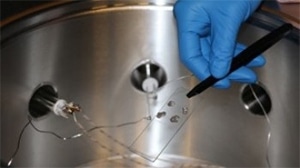Jul 26 2016
The unique and valuable properties of graphene – a wonder material noted for its strength and electrical conductivity – are being leveraged by Masdar Institute researchers to help advance technologies of relevance to strategic local industries like oil and gas and desalination.
 Researches Look to Graphene to Support Desalination and Energy in Abu Dhabi. (Credit: Masdar Institute of Science and Technology)
Researches Look to Graphene to Support Desalination and Energy in Abu Dhabi. (Credit: Masdar Institute of Science and Technology)
“The graphene market is still relatively new and in the early stages of development with only a few products being commercialized to date. However, strong growth of graphene and other related 2-dimensional materials is expected due to superior strength, weight, conductivity, and transparency properties. That is why Masdar Institute is working to utilize graphene to develop new membranes, sensors and composites,” said Dr. Steve Griffiths, Vice President for Research and Interim Associate Provost at Masdar Institute.
One such project is co-led by Dr. Irfan Saadat, Professor of Electrical Engineering, and Dr. Amal Al Ghaferi, Assistant Professor of Materials Science and Engineering. They are using graphene and carbon nanotubes to develop smart sensors for deployment in oil and gas pipelines. The research is part of a collaboration with ADNOC and the Petroleum Institute and aims to detect and monitor the build-up of scaling or impurities inside gas and oil pipelines.
Graphene and carbon nanotubes were used to make the scale sensors using two different synthesis methods. These sensors will help oil and gas plants operate at optimized levels and thus recover more oil from their pipelines. This will improve the operational efficiency of the UAE’s oil and gas industry, which is a vital pillar of the economy.
“Given that graphene is a 2D material, it has very unique properties that are not available in typical bulk-3D materials. These include the fact that it is highly conductive, very strong, thermally conductive and transparent. They also are inert and chemically and thermally stable, which opens a wider window for hostile environment applications,” Dr. Saadat explained.
Graphene is made of a single layer of carbon atoms. Its unique structure – a repeating pattern of hexagons – lends it some very unique physical and electromechanical characteristics. It is said to be the strongest material in the world and electrons move through graphene so quickly they appear to be massless. These characteristics result in a material that has the power to transform electronics, computing and many other technologies.
Dr. Saadat and Dr. Al Ghaferi are also contributing to a collaborative graphene research project with the University of Manchester that is being led by Dr. Ibraheem Almansouri, Assistant Professor of Microsystems Engineering at Masdar Institute. The project is exploring the use of inkjet-printed graphene micro-sensors that can be used in the energy applications targeting oil and gas sector. By leveraging inkjet printing, which is a low-cost and mass scalable material production method, this project aims to make the fabrication of graphene sensors easy, affordable, portable, and flexible. Dr. Almansouri said: “The success of fabricating these inexpensive and flexible sensors relying on the favorable properties of graphene will expand the application domain upon the completion of this project.” The project is part of a collaborative partnership the University of Manchester, which is the institute credited with discovering graphene. The joint research program focuses on "pre-competitive" research in graphene and related 2D materials for sensors, membranes and composites for the aerospace, defense and energy markets.
Graphene also has the potential to improve the way the UAE produces freshwater from seawater. French environmental resource company Veolia has sponsored a project led by Dr. Linda Zou, Professor of Chemical and Environmental Engineering, to leverage graphene’s excellent electrical properties to improve the effectiveness of capacitive deionization (CDI). CDI is a desalination technology that uses an electric charge to remove salt from water, which is potentially a less energy intensive desalination process than those that rely on heat, chemicals or high-pressure membrane systems.
Masdar Institute students are also helping to advance the applications of graphene to strategic UAE sectors and real-world challenges.
MSc graduate and current PhD student Chia-Yun Lai’s Master’s thesis research characterizing the surface wettability of graphene and fish scales garnered significant attention from the scientific community.
Surface wettability is the ability of a liquid to maintain contact with a solid surface. It is important in a number of applications of relevance to the industries targeted in the UAE, including development of semiconductor wafers, electronics, plastics, etc.
As part of her research, conducted under the guidance of her faculty advisor Dr. Matteo Chiesa, Lai developed a new wettability investigation technique and tested its ability to study wettability of graphene and fish scales at the nano level. Through her research Lai joined the first investigators around the world to establish the relationship between different length-scale wettability measurements for improved spatial resolution. Her work resulted in five papers published, including four peer-reviewed journal papers, and one conference paper.
Beyond sensors and composites, graphene is expected to be integral to the next innovations in wearable electronic devices, aviation components, broadband photodetectors, radiation-resistant coatings, and energy storage. According to research in ‘Graphene Markets, Technologies and Opportunities 2014-2024,’, the markets for graphene will grow from around US$20 million in 2014 to more than US$390 million in 2024.